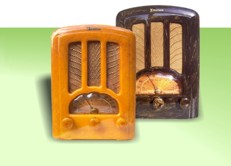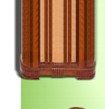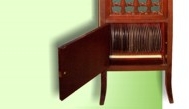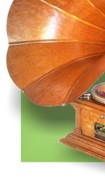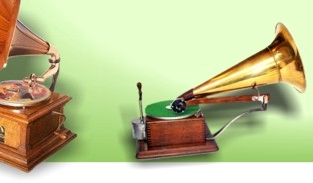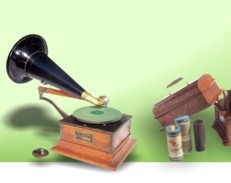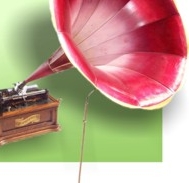In a Nutshell
Be careful when choosing: in North America you need not only a 110V powered, but also a 60Hz powered model like this from licensee Rogers Majestic
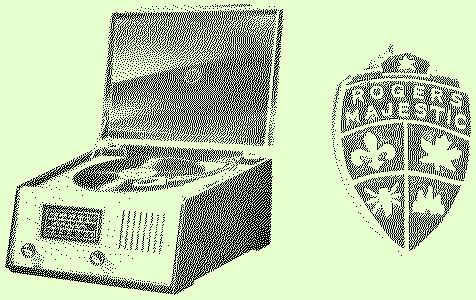
Introduction:
This lovely and rare radio-gramophone combo (Radiogram) is best known under its Philips Eindhoven model number HX347A-61, but also available as Philips Canada model P251, or as the even rarer Rogers Majestic licenced model R651. Be careful when choosing: in North America you need a 110V/60Hz version, like this one on auction. Philips radios are extremely well documented (ref.s 1-4). The Dutch model number is deciphered as follows:
H = Hi-Fi-Gerät (table model with gramophone), B would be a table model, how mnemonic !
X = Philips Benelux
3 = Price range (from 0-9 increasing)
4 = 1954 (last digit of year 1946 - 55)
7 = number distinguishing from pre-1946 scheme
A = AC powered
61 = specifying 110V 60Hz version
What we have is an AM radio (185 - 580m, 1622 - 517 kHz), integrated with a 3-speed record player AG 2002-46 powered by 110V, 60Hz. The radio is a conventional AA5 (All American Five Tube) superheterodyne receiver, used by Philips also in other radios. Switch to gramophone is on top ("R / PU" in pict.17). The case is Philite (Philips' trade mark for Bakelite), painted ivory on front and top with the Rogers Majestic crest on top.
3-speed record player integrated in the Philite case. Transparent cover with hinges on the rear, 1.5 lbs heavy turntable platter covered with red felt mat, largely eliminates wow and flutter. Automatic switch-off at end of record, crystal pick-up with twin sapphire needles replaced by NOS ceramic flip-flop two-needle jukebox cartridge for 78 rpm and microgroove (45 and 33 rpm).
Additional information:
ref.1: http://www.radiotechniek.nl/radiotechniek.php
ref.2: http://www.datastress.com/~mario/radio/radio.shtml
ref.3: https://www.radiomuseum.org/r/philips_hx347a.html, https://www.radiomuseum.org/r/philips_p251.html
https://www.radiomuseum.org/r/rogerstube_r651.html
ref.4: http://www.grammofoon.com/frameset.htm?http://www.grammofoon.com/Philips/Philips_HX348A.htm&ContentFrame
ref.5: https://youtu.be/6najhAQXnI0
About my radiogram:
After detailed and thorough inside and outside cleaning and servicing, the radio and the record player work flawlessly. I had to replace the idler wheel, as seen in pict.19. The former owner had stored the unit with the speed selector not in off position, such that the wheel was pressing against the motor spindle, causing it to get a little dent. As an aside: please, if you ever have to store a technical antique away, make sure to avoid long-term silent damages, like this one or the infamous battery leakage. I decided not to replace the filter condensors, because there is no hum at all. The otherwise non-aging Philips tar-encased paper capacitors were replaced, because they were physically damaged. My "near mint" classification of the set refers to three minor issues: 1. the ivory paint had three or four very small (mm) spots where the brown bakelite came through, far too minor to even take pictures of. 2. the little wire bracket, clamping the tonearm down during transport, is replaced (pict.17). 3. there are a few small and unoffending scratches on top of the transparent cover lid, also hard to photograph. They could be buffed out with a little patience, since the acrylic is very thick (4mm). The radio tunes in stations better than many other AM radios, especially when equipped with a long wire at the antenna input. The sound is full, powerful and well balanced. The original swiveling cartridge has been replaced by a modern ceramic jukebox cartridge with flip-flop needles. A 3.5mm closed circuit phone plug has been installed to connect mp3 players, cellphones and other devices. You can watch and hear the set working by clicking on the last thumbnail below or going to ref. 5 to watch a youtube video.
A lovely and fully usable radio - phono combination, needing only a small space. An eye and ear candy, with its original red felt mat and the two filigree knobs. Please
e-mail me (Kris) for any questions, ich spreche Deutsch, je parle Français.
For the techies only: The tube lineup of the original Dutch HX347A-61 receiver is UCH42(14V) UF41(12.6V) UBC41(14V) UL41(45V) UY41(31V). The numbers in brackets are the tubes heater voltages, adding up to 117Volt, so the heaters could be connected in series and powered directly from 120V AC. The "U" means that the heater current is 100mA. When connected to 220V, half of the power had to be burned in resistors. All American Five (AA5) radios use totally different tubes, differing mainly in the heater voltages. The Rogers Majestic R651 on auction and the Canadian P251 have this very common tube complement: 12AJ7, 12BA6, 12AV6, 50C5, 35W4, where the leading digits of the tube names depict their heater voltages, again adding up to the line voltage of 121Volt. It seems this radiogram was targeting primarily non-European markets. Interesting is the use of the 12AJ7, a triode-heptode, instead of the Dutch UCH42, a triode-hexode.
|
Here are the specifications:
Technical Description of Item |
| Manufacturer |
Rogers Majestic Corp. Ltd., Toronto, licenced by Philips Gloeilampenfabrieken Holland |
| Model |
R651 |
| Serial number |
360007 |
| Production Year |
1955 |
| Type |
AC-powered 5-tube superheterodyne receiver with integrated 3-speed record player |
| Cabinet |
Philite (Philips bakelite), front and top ivory painted |
| Dial and knobs |
Illuminated glass dial, 2 original gold-decorated filigree bakelite knobs |
| Frequency Range |
AM 1622 - 517 kHz |
| Tube line-up |
12AJ7 (oscillator and mixer), 12BA6 (IF amplifier), 12AV6 (detector and AF pre-amplifier), 50C5 (output amplifier), 35W4 (mains rectifier) |
| Size (WxDxH) |
15" x 14" x 8" |
| Weight |
8 kg = 17 pounds |
| Extras |
Custom-installed 3.5mm closed circuit phone adapter for mp3, cellphone, ... |
| Comment |
Beautiful very compact antique radiogram, in near mint, working and serviced condition |
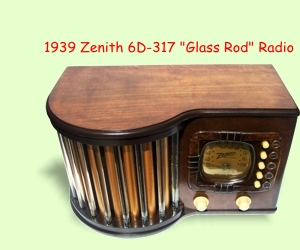 |
Shipping and handling:
EBay's shipping calculator is not working. You can estimate shipping costs with the help of CanadaPost's shipping calculator.
Take my Canadian postal code V2R5P6 and remember yours, take size and weight from the above table, add estimated box padding and weight and choose between the different shipping options. Don't forget insurance! |
 | |
|



